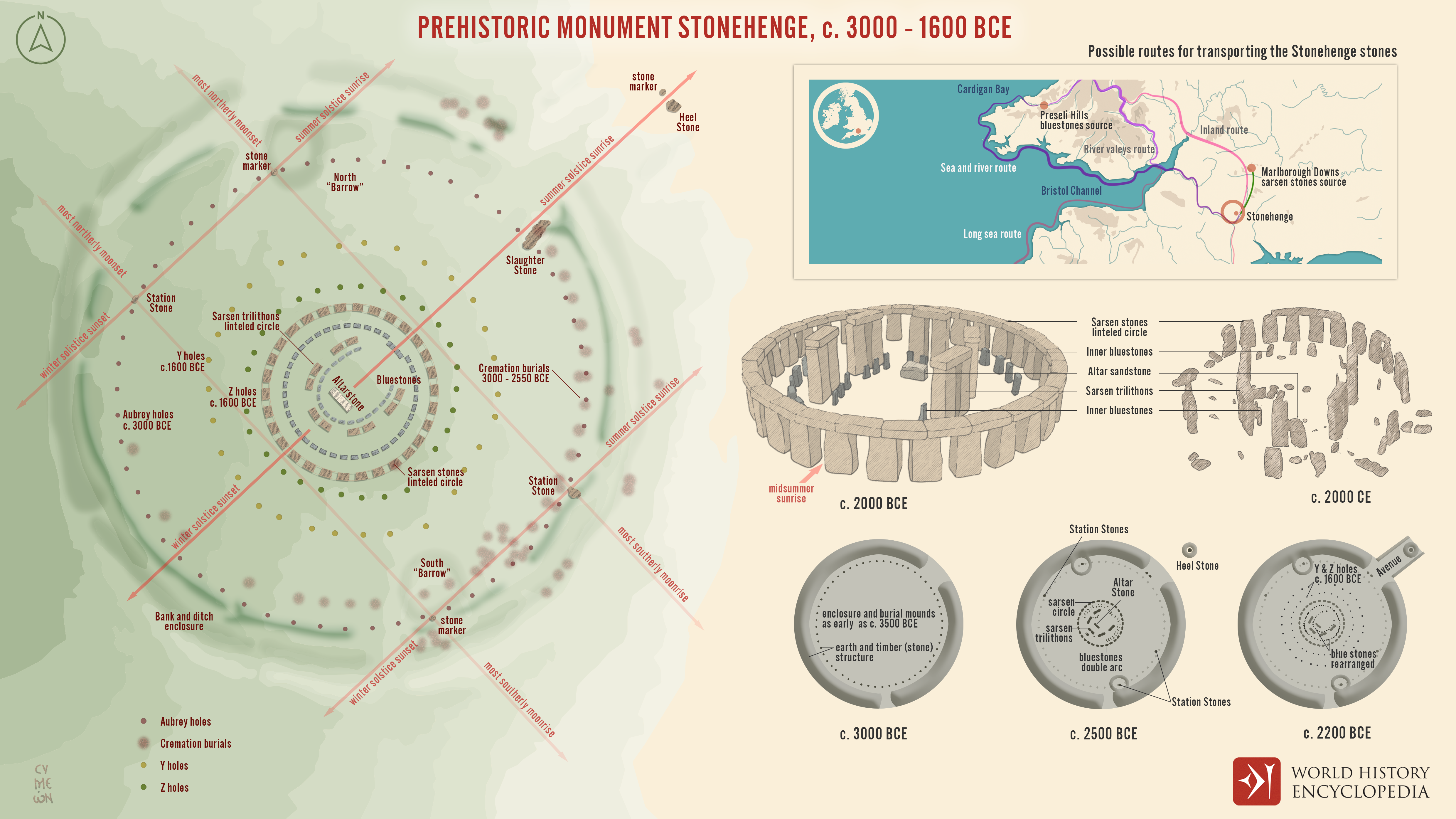Overview
Introduction to Stonehenge
Stonehenge is a prehistoric monument located in Wiltshire, England. It consists of a ring of standing stones, each weighing around 25 tons, with lintels on top. The monument is believed to have been constructed between 3000 and 2000 BCE, during the Neolithic period. Stonehenge is one of the most famous archaeological sites in the world and has been the subject of much speculation and mystery. While many people associate Stonehenge with ancient rituals and astronomical alignments, there are several other intriguing sites in the vicinity That Aren’t Stonehenge. These lesser-known sites provide valuable insights into the Neolithic culture and shed light on the purpose and function of Stonehenge itself.
Historical Background
Stonehenge’s historical background is rich and fascinating. It is believed that the construction of Stonehenge began around 3000 BCE and continued for over 1,000 years. The site has been a place of great significance in ancient cultures, serving as a gathering place for religious ceremonies and rituals. It is a testament to the ingenuity and engineering skills of the Neolithic people who built it. The purpose and function of Stonehenge have long been debated by archaeologists and historians, with theories ranging from it being a burial ground to an astronomical observatory. Regardless of its exact purpose, Stonehenge’s importance in ancient cultures cannot be denied.
Purpose and Function
The purpose and function of Stonehenge have been the subject of much speculation and debate. Stonehenge surprising research by Mike Parker Pearson has shed new light on the possible purpose of this ancient monument. According to Pearson’s research, Stonehenge was not just a place of worship or a burial site, but rather a center for healing and a pilgrimage destination. The construction of Stonehenge involved the use of massive stones, some weighing up to 25 tons, which were transported from quarries over long distances. The engineering techniques used to erect these stones are still not fully understood. The timeline of construction spans several centuries, suggesting that Stonehenge was a long-term project. The alignment of Stonehenge with celestial bodies, such as the summer solstice sunrise and the winter solstice sunset, has led to theories about its astronomical significance. Some researchers believe that Stonehenge was used as an observatory or a calendar to track the movements of the sun and the moon. However, the true purpose and function of Stonehenge remain a mystery, and further archaeological discoveries and research are needed to unravel its secrets.
Construction of Stonehenge

Building Materials
The construction of Stonehenge involved the use of various types of building materials. The most notable material used in the construction of the monument is bluestone, which was transported from the Preseli Hills in Wales, over 150 miles away. These bluestones were carefully shaped and arranged to form the inner circle of the monument. Another type of stone used in the construction is sarsen, a type of sandstone found in the local area. The sarsen stones, weighing up to 30 tons each, were used to create the iconic outer circle and trilithons. The transportation and shaping of these massive stones required advanced engineering techniques and a significant amount of manpower. The use of different types of stones from different locations has led to controversial findings about Stonehenge, with some theories suggesting that the monument was built as a symbol of unity and connection between different communities.
Engineering Techniques
The construction of Stonehenge involved impressive engineering techniques that continue to puzzle researchers today. The monument was built using a combination of large stones, known as sarsens, and smaller stones, called bluestones. These stones were transported over long distances, with some weighing up to 25 tons. The engineering feat of moving and placing these massive stones with precision is a testament to the skill and ingenuity of the Neolithic people. Additionally, the arrangement of the stones in various formations, such as the iconic trilithons, showcases the advanced knowledge of geometry and architecture possessed by the builders. The exact methods used to transport and raise the stones remain a mystery, as no written records from that time exist. However, various theories, ranging from the use of sledges and ramps to the involvement of supernatural forces, have been proposed. Deciphering the engineering techniques employed at Stonehenge is crucial to understanding the monumental effort that went into its creation and adds to the intrigue surrounding this ancient wonder of the world.
Timeline of Construction
The construction of Stonehenge took place over several centuries, with different phases of building and modifications. Timeline of Construction provides insights into the evolution of the monument. The earliest phase, known as the Henge phase, involved the digging of a circular ditch and the erection of large timber posts. This was followed by the construction of the iconic stone circle, which consisted of massive standing stones arranged in a circular pattern. The stones were carefully shaped and transported from quarries located miles away. The final phase of construction saw the addition of lintels, which were placed on top of the standing stones to create the famous trilithons. The timeline of construction reveals the meticulous planning and engineering skills of the Neolithic people who built Stonehenge. It is a testament to their dedication and ingenuity in creating a monument that has captivated the world for centuries.
Mysterious Alignments

Alignment with Celestial Bodies
Stonehenge’s remarkable alignment with celestial bodies has long fascinated scientists and historians. The positioning of the stones suggests a deep understanding of astronomical phenomena by the Neolithic builders. Archaeological excavations have revealed that specific stones were strategically placed to align with the movements of the sun, moon, and stars. This precise alignment is believed to have served a significant purpose, possibly related to religious or ceremonial practices. The careful observation and calculation required to achieve such precise alignment are a testament to the advanced knowledge and skills of the ancient builders. The archaeological excavation of Stonehenge continues to uncover new insights into the purpose and significance of its celestial alignments.
Astronomical Significance
Stonehenge’s astronomical significance is one of its most intriguing aspects. The alignment of the stones with celestial bodies suggests a deep understanding of the cosmos by the Neolithic people who built it. Some researchers believe that Stonehenge was used as an astronomical observatory, allowing ancient astronomers to track the movements of the sun, moon, and stars. This theory is supported by the fact that certain stones align with the solstices and equinoxes, indicating a deliberate design. Other theories propose that Stonehenge had religious or ceremonial purposes, with the alignment of the stones playing a symbolic role in the rituals performed at the site. The significance of these alignments is still a subject of debate and continues to fascinate archaeologists and astronomers alike.
Theories and Speculations
One of the most intriguing aspects of Stonehenge is the origin of its giant stones. These massive rocks, some weighing up to 25 tons, were transported over long distances to the site. The exact source of these stones has been a subject of much debate and speculation among archaeologists and geologists. Some theories suggest that the stones were quarried from nearby areas, while others propose that they were brought from as far away as Wales. The mysterious origins of these stones add to the enigma surrounding Stonehenge and continue to fuel research and investigation.
Decoding the Neolithic Giant

Archaeological Discoveries
Archaeological discoveries at Stonehenge have provided invaluable insights into the ancient Neolithic civilization that constructed this monumental site. Excavations have revealed the presence of ancient Stone Age holes in England, known as Aubrey Holes, which are believed to have played a significant role in the construction of Stonehenge. These circular pits, named after John Aubrey who first identified them in the 17th century, are arranged in a circular pattern within the monument. The purpose of these holes remains a mystery, but they are thought to have held wooden posts or stones that may have served as markers or contributed to the alignment and positioning of the stones. The discovery of these holes has shed light on the meticulous planning and engineering skills of the Neolithic people who built Stonehenge, and their deep connection to the landscape and celestial observations.
Symbolism and Rituals
The symbolism and rituals associated with Stonehenge are a subject of great fascination and speculation. The ancient monument’s unique design and alignment with celestial bodies have led to numerous theories about its purpose and function. One of the most intriguing facts about Stonehenge is its precise alignment with the summer solstice sunrise, suggesting a connection to ancient astronomical practices. Some researchers believe that the site was used for religious ceremonies and rituals, possibly related to fertility and the cycles of nature. The presence of burial mounds and cremation remains also suggests that Stonehenge may have served as a sacred burial ground. However, the exact meaning and significance of these rituals remain a mystery, leaving room for ongoing research and speculation.
Unanswered Questions and Future Research
Unanswered Questions and Future Research
There are still many unanswered questions surrounding Stonehenge, leaving room for future research and exploration. One of the main mysteries is the purpose of the monument and the significance of its various alignments. While it is believed to have had a ceremonial or religious function, the exact rituals and symbolism remain unclear. Additionally, the engineering techniques used to construct such a massive structure with limited tools and resources continue to baffle researchers. The timeline of construction is also a subject of debate, with different theories suggesting multiple phases of building. Future investigations may shed light on these mysteries and provide a deeper understanding of the Neolithic giant that is Stonehenge.
- What was the purpose of Stonehenge?
- How were the alignments with celestial bodies achieved?
- What were the specific rituals and symbolism associated with the monument?
- How were the engineering techniques used to build Stonehenge?
- What was the timeline of construction?
- Are there any other undiscovered features or structures in the surrounding area?
In conclusion, Stonehenge continues to captivate the imagination of researchers and visitors alike, and the quest to decode its secrets is far from over.
Conclusion
In conclusion, Stonehenge remains one of the most enigmatic and fascinating ancient structures in the world. Its construction, alignment with celestial bodies, and the symbolism and rituals associated with it continue to intrigue researchers and archaeologists. Through archaeological discoveries, such as the recent findings of prehistoric pits near Stonehenge, we gain valuable insights into the lives of the Neolithic people who built this monumental site. These pits, which date back thousands of years, provide evidence of human activity and possibly rituals that took place in the vicinity of Stonehenge. Despite the numerous theories and speculations, many questions about Stonehenge still remain unanswered, leaving room for future research and exploration. The mysteries surrounding Stonehenge are a testament to the ingenuity and mysteries of our ancient ancestors, and it is through ongoing investigations that we hope to uncover more about this Neolithic giant.
Avid Writer with invaluable knowledge of Humanity!
Upcoming historian with over 30 million views online.
“You make your own life.”






